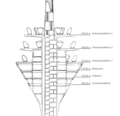Tower cage
Tower cage , rarely called tower head , is a mostly cantilevered structure of a television or observation tower with an often round base, which is usually located in the upper area of the tower shaft . The name originated after Kleinmann / Weber when planning the Stuttgart TV tower in 1956 through the association with the masthead of a ship.
function
In many cases, the tower cage of television towers houses the operating floors for the employees of the radio equipment. In observation towers and in publicly accessible television towers, there are observation platforms in the tower cage or separately from it . Some of these towers also have a revolving restaurant .
Service and public floors of television towers are usually located in a single tower cage. In some cases these are also housed separately, such as the Black Mountain Tower in Canberra , the Heinrich Hertz Tower in Hamburg or the Olympic Tower in Munich , where the Bundespost and the city could not agree.
Designs
The majority of the towers have, in order to offer the least possible surface to the wind blowing from all sides, around the shaft regularly circularly arranged tower baskets like circular cylinders . Examples are the Olympic Tower , the Danube Tower and the Tashkent TV Tower . The Stratosphere Tower in Las Vegas, the Rhine Tower , the TV tower Yerevan and the Stuttgart TV tower have upside-down truncated cones , the latter consisting of a cylinder on the top floor and a cone below.
The Berlin TV tower and the Oriental Pearl Tower have the rather rare spherical shape . Different ellipsoids of rotation can be found on the Nuremberg telecommunications tower , or parts of it at the central television tower in Beijing .
Sometimes you will find shapes regularly arranged at a 120 ° angle, which at least evenly distribute the basic load, as in the Prague TV tower , Euromast or Torre de Collserola . There are also asymmetrical tower baskets, such as can be seen at the Telemax in Germany or even more at the St. Chrischona television tower in Switzerland . In the case of the latter, the one-sided load from 200 m³ of water had to be taken into account, without which the tower was slightly crooked during construction.
A further special form are buildings that have a tower stump with a tower cage on top of a building, as if growing out of it, or that have a full tower built into the building away from the foundation. It can be a utility building like the former Henninger Tower granary in Frankfurt , or high-rise buildings or skyscrapers like the Vancouver Lookout in the Harbor Center in Vancouver .
The Bordsch-e Milad in Tehran has the largest tower cage in terms of usable area .
- Varieties of tower baskets
Classic tower cage at the Stuttgart TV tower
Spherical shape of the Berlin television tower
Egg shape of the Nuremberg telecommunications tower
Truncated cone combination at the Mannheim telecommunications tower
Goblet shape at the Düsseldorf Rhine Tower
Asymmetrical polygonal structure at the St. Chrischona TV tower
The overhang of the tower cage is intended to provide more space in the generally very slim television and observation towers. However, there are also examples of only slightly overhanging tower baskets such as the Ostankino television tower in Moscow or the Emley Moor television tower . In fact, the are not projecting Canton Tower , which has all installations within its shell, the Kiev TV Tower , Riga Radio and TV Tower and the Eiffel Tower in Paris is - how many steel truss towers - without projecting tower cage. These examples include the Thyssenkrupp test tower in Rottweil , which in its upper part houses the highest viewing platform in Germany.
literature
- Erwin Heinle , Fritz Leonhardt : Towers of all times, of all cultures. Deutsche Verlags-Anstalt, Stuttgart 1997, ISBN 3-421-02931-8 .
- Dietrich Elias (Hrsg.): Yearbook of the electrical telecommunications. Verlag für Wissenschaft und Leben Georg Heidecker, Bad Windsheim 1974, ISBN 3-87862-125-6 , pp. 24–26 and 91–100.
Individual evidence
- ↑ Heinle, Leonhardt: Towers of all times, of all cultures , page 222 f
- ^ Joachim Kleinmanns, Christiane Weber: Civil engineering: The beginnings of prestressed concrete construction . In: Beton- und Stahlbetonbau , Vol. 104, No. 6, pp. 372–379, June 2, 2009
- ^ Harbor Center , on emporis.com






